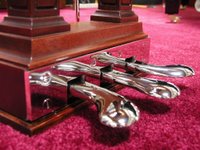What do all three pedals do on a piano?
 A google Search on "piano+pedal+uses" resulted in another spot-on explanation from the indefatigable Cecil Adams of the Straight Dope. Pianist Jeffrey Chappell also offers a lengthier explanation of the ups and downs of pedal-pushing.
A google Search on "piano+pedal+uses" resulted in another spot-on explanation from the indefatigable Cecil Adams of the Straight Dope. Pianist Jeffrey Chappell also offers a lengthier explanation of the ups and downs of pedal-pushing. In a nutshell, here's how they work:
Right pedal - The loud one. Also known as the "forte" or sustain pedal, it prevents dampers from descending on the piano strings, resulting in a rich, sustained chord peal.
Left pedal - The soft one or " una corda." A single piano note is normally created from two or three piano strings tuned in unison. This pedal shifts the hammer so that it hits only one or two strings, resulting in a more muted sound. Hence, "una corda" or "one string."
Middle pedal - The "sostenuto." This pedal selectively sustains notes, so that certain notes can ring out while others fade normally. It is usually found only on grand pianos.
Mr. Chappell reminds you that when pushing pedals, the heels of your feet should remain touching the floor at all times. So have fun, but play safe
Receive post updates by Email



























 Add my feed to your Rss
Add my feed to your Rss
